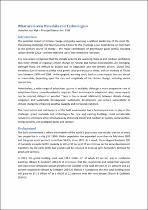JavaScript is disabled for your browser. Some features of this site may not work without it.
- ResearchSpace
- →
- Research Publications/Outputs
- →
- Book Chapters
- →
- View Item
| dc.contributor.author |
Van Wyk, Llewellyn V

|
|
| dc.date.accessioned | 2015-02-09T07:23:47Z | |
| dc.date.available | 2015-02-09T07:23:47Z | |
| dc.date.issued | 2014-10 | |
| dc.identifier.citation | Van Wyk, L. 2014. What are green materials and technologies? In: Green Building Handbook, South Africa: Volume 7: Materials and Technologies, Alive2green, Cape Town, South Africa, pp 24-37 | en_US |
| dc.identifier.isbn | 978-0-620-542403 | |
| dc.identifier.uri | http://issuu.com/alive2green/docs/mat_techhandbook_web/1 | |
| dc.identifier.uri | http://hdl.handle.net/10204/7853 | |
| dc.description | Green Building Handbook, South Africa: Volume 7: Materials and Technologies | en_US |
| dc.description.abstract | The potential impact of climate change and global warming is without doubt one of the most life-threatening challenges that face humanity. Central to this challenge is our dependence on fossil fuels as the primary source of energy- the major contributors of greenhouse gases (GHGs) including carbon dioxide (CO(sub2)) - and the extensive use of non-renewable resources. It is now widely recognised that the climate systems are warming: there is also medium confidence that other effects of regional climate change on natural and human environments are emerging, although many are difficult to discern due to adaptation and non-climatic drivers. Global GHG emissions due to human activities have grown since pre-industrial times, with an increase of 70 per cent between 1970 and 2004 . Anthropogenic warming could lead to some impacts that are abrupt or irreversible, depending upon the rate and magnitude of the climate change, including severe species loss. Nevertheless, a wide range of adaptation options is available, although a more progressive rate of adaptation than is currently evident is required. Given an increase in adaptation rates, many impacts can be reduced, delayed or avoided. There is thus a causal relationship between climate change mitigation and sustainable development: sustainable development can reduce vulnerability to climate change by enhancing adaptive capacity and increasing resilience. The construction and maintenance of the built environment has a fundamental role to play in this challenge: green materials and technologies for new and existing buildings could considerably reduce CO(sub2) emissions while simultaneously improving indoor and outdoor air quality, social welfare, energy security, and ecological goods and services. | en_US |
| dc.language.iso | en | en_US |
| dc.publisher | Alive2Green | en_US |
| dc.relation.ispartofseries | Workflow;14132 | |
| dc.subject | Green materials | en_US |
| dc.subject | Energy security | en_US |
| dc.subject | Green buildings | en_US |
| dc.subject | Climate change | en_US |
| dc.subject | Water | en_US |
| dc.subject | Global warming | en_US |
| dc.title | What are green materials and technologies? | en_US |
| dc.type | Book Chapter | en_US |
| dc.identifier.apacitation | Van Wyk, L. V. (2014). What are green materials and technologies?., <i>Workflow;14132</i> Alive2Green. http://hdl.handle.net/10204/7853 | en_ZA |
| dc.identifier.chicagocitation | Van Wyk, Llewellyn V. "What are green materials and technologies?" In <i>WORKFLOW;14132</i>, n.p.: Alive2Green. 2014. http://hdl.handle.net/10204/7853. | en_ZA |
| dc.identifier.vancouvercitation | Van Wyk LV. What are green materials and technologies?.. Workflow;14132. [place unknown]: Alive2Green; 2014. [cited yyyy month dd]. http://hdl.handle.net/10204/7853. | en_ZA |
| dc.identifier.ris | TY - Book Chapter AU - Van Wyk, Llewellyn V AB - The potential impact of climate change and global warming is without doubt one of the most life-threatening challenges that face humanity. Central to this challenge is our dependence on fossil fuels as the primary source of energy- the major contributors of greenhouse gases (GHGs) including carbon dioxide (CO(sub2)) - and the extensive use of non-renewable resources. It is now widely recognised that the climate systems are warming: there is also medium confidence that other effects of regional climate change on natural and human environments are emerging, although many are difficult to discern due to adaptation and non-climatic drivers. Global GHG emissions due to human activities have grown since pre-industrial times, with an increase of 70 per cent between 1970 and 2004 . Anthropogenic warming could lead to some impacts that are abrupt or irreversible, depending upon the rate and magnitude of the climate change, including severe species loss. Nevertheless, a wide range of adaptation options is available, although a more progressive rate of adaptation than is currently evident is required. Given an increase in adaptation rates, many impacts can be reduced, delayed or avoided. There is thus a causal relationship between climate change mitigation and sustainable development: sustainable development can reduce vulnerability to climate change by enhancing adaptive capacity and increasing resilience. The construction and maintenance of the built environment has a fundamental role to play in this challenge: green materials and technologies for new and existing buildings could considerably reduce CO(sub2) emissions while simultaneously improving indoor and outdoor air quality, social welfare, energy security, and ecological goods and services. DA - 2014-10 DB - ResearchSpace DP - CSIR KW - Green materials KW - Energy security KW - Green buildings KW - Climate change KW - Water KW - Global warming LK - https://researchspace.csir.co.za PY - 2014 SM - 978-0-620-542403 T1 - What are green materials and technologies? TI - What are green materials and technologies? UR - http://hdl.handle.net/10204/7853 ER - | en_ZA |






